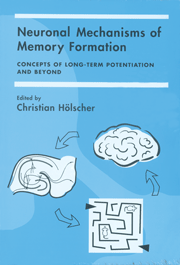Book contents
- Frontmatter
- Contents
- Contributors
- Introduction: Long-Term Potentiation as a Model for Memory Mechanisms: The Story So Far
- Section One Long-Term Potentiation In Vitro and In Vivo: How Can We Fine-Tune the Current Models for Memory Formation?
- 1 Persisting with Long-Term Potentiation as a Memory Mechanism: Clues from Variations in Long-Term Potentiation Maintenance
- 2 Long-Term Potentiation in the Amygdala: Implications for Memory
- 3 Multiple Roles for Synoptic Plasticity in Pavlovian Fear Conditioning
- 4 Plasticity of the Hippocampal Cellular Representation of Space
- Section Two There is More to the Picture Than Long-Term Potentiation: Theta or Gamma Oscillations in the Brain and the Facilitation of Synaptic Plasticity
- Section Three Making Models from Empirical Data of Synaptic Plasticity
- Section Four Setting the Stage for Memory Formation: Stress, Arousal, and Attention
- Section Five Transgenic Mice as Tools to Unravel the Mechanisms of Memory Formation
- Conclusions and Future Targets
- Index
2 - Long-Term Potentiation in the Amygdala: Implications for Memory
Published online by Cambridge University Press: 13 October 2009
- Frontmatter
- Contents
- Contributors
- Introduction: Long-Term Potentiation as a Model for Memory Mechanisms: The Story So Far
- Section One Long-Term Potentiation In Vitro and In Vivo: How Can We Fine-Tune the Current Models for Memory Formation?
- 1 Persisting with Long-Term Potentiation as a Memory Mechanism: Clues from Variations in Long-Term Potentiation Maintenance
- 2 Long-Term Potentiation in the Amygdala: Implications for Memory
- 3 Multiple Roles for Synoptic Plasticity in Pavlovian Fear Conditioning
- 4 Plasticity of the Hippocampal Cellular Representation of Space
- Section Two There is More to the Picture Than Long-Term Potentiation: Theta or Gamma Oscillations in the Brain and the Facilitation of Synaptic Plasticity
- Section Three Making Models from Empirical Data of Synaptic Plasticity
- Section Four Setting the Stage for Memory Formation: Stress, Arousal, and Attention
- Section Five Transgenic Mice as Tools to Unravel the Mechanisms of Memory Formation
- Conclusions and Future Targets
- Index
Summary
SUMMARY
Since the discovery that neurons connect to each other via synapses, it has been hypothesized that experience leads to modifications in these connections, and that memory is embodied in these changes. Application of the cellular-connection approach to the study of the plasticity of defense responses to sensory cues has proved to be a particularly fruitful means of studying the relation of learning to changes in synaptic transmission – first in Aplysia, and, more recently, in studies of classical fear conditioning in the rodent. The discovery of artificial means of inducing neural plasticity (longterm potentiation, LTP) has added an important tool for the examination of plasticity mechanisms in specific pathways identified through the successful application of the cellular-connection approach. The demonstration that sensory pathways to the amygdala critical for fear conditioning are susceptible to LTP induction has led to examination of the mechanisms underlying LTP in the amygdala, the ability of these mechanisms to modulate sensory transmission, and their relation to the learning-induced changes in sensoryevoked neural activity that accompany fear conditioning.
Introduction
Learning refers to the acquisition of new information about the world and memory to the storage of that information over time. In his Croonian lecture to the Royal Society in 1894, Ramon y Cajal suggested that learning involves alterations in the strength of connections between neurons, and that these alterations in synaptic strength might persist and underlie memory storage. Although subsequent demonstrations that certain synapses are capable of undergoing functional modification were not uncommon (e.g., Eccles, 1964), such changes were short lasting and not clearly related to the acquisition and storage of information.
- Type
- Chapter
- Information
- Neuronal Mechanisms of Memory FormationConcepts of Long-term Potentiation and Beyond, pp. 58 - 76Publisher: Cambridge University PressPrint publication year: 2000
- 2
- Cited by



